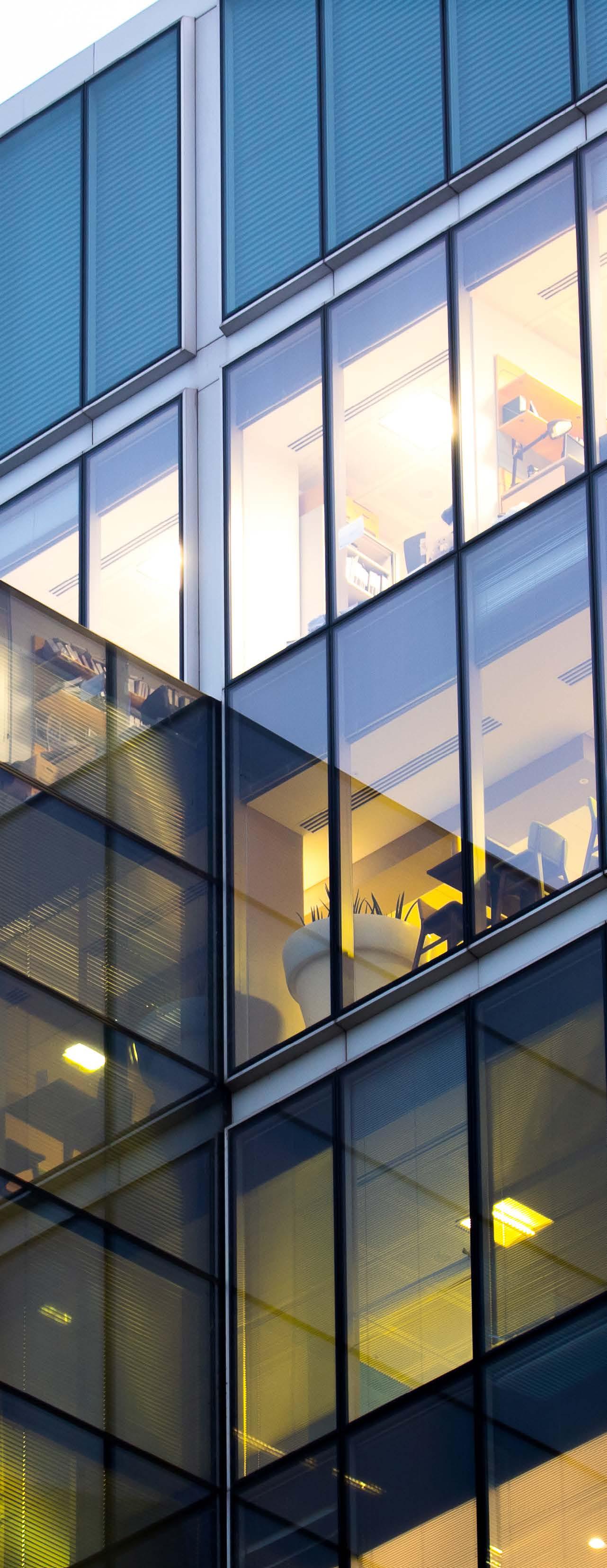
6 minute read
Up Close and Personal
By Mark S. Rea, PHD Light and Health Research Center at Mount Sinai.
It’s probably fair to say that lighting design for commercial spaces is mostly limited to the specification of ceiling luminaires, framed in terms of lighting energy codes and IES horizontal illuminance recommendations. Exceptions are lobbies, conference rooms, cafeterias, and other gathering places where aesthetics and flexibility are important. Most of the lighting “acreage” is, however, dedicated to providing general illumination to the office worker.
The pandemic has changed the workplace. The United States General Services Administration (GSA) reports that 85% of federal employees work both at home and in the office during any given week. This statistic is not surprising to employers. Office workers now want to minimize long commutes as well as the time spent in bland, one-size-fits all commercial workplaces.
Real estate owners have always depended upon employer tenants to occupy their commercial buildings and pay rent while, in turn, employers have always expected suitable accommodations for their employees to work productively. This pre-pandemic arrangement provided building owners with a steady, predictable return on their capital investment and allowed employers to concentrate on worker productivity.
Post-pandemic, occupancy rates in commercial spaces are at an all-time low, so owners are trying to entice employers to stay in their buildings, while employers are renegotiating rental costs and the amount of space needed to house their employees.
In this new commodity-driven world of lighting, the future should not be about making ceiling lighting still cheaper. Rather, untapped opportunities lie in the creation of luminous environments where workers actually want to come to the office. The opportunities lie in making workplace lighting personal.
Sure, that sounds good, but what exactly does that mean?
It first means that manufacturers, specifiers, and architects need to stop thinking about lighting as ceiling furniture. Of course, every building needs general illumination for circulation, and our visual system is so adaptable that bland, general illumination works, not just for circulation, but for paper-based tasks as well — turn the lights on, you see; turn them off, you don’t.
Why make it more complicated?
For the same reason that ergonomic chairs were developed. It’s not enough to simply give the worker a place to sit — we can pretty much sit on anything. Rather, today office seating is all about ergonomic chairs. Unlike lighting designers who constantly battle value engineering, interior designers never have their ergonomic chairs value-engineered out of the project. Everyone now recognizes that sitting is personal; the same can and should be said about lighting — it’s time to make workplace lighting personal.

If lighting is not about impersonal ceiling furniture, what are we talking about?
In short, lighting needs to be “up close and personal.” A first step would be to take advantage of the inverse square law by routinely providing a circadian-effective lighting layer in proximity to the individual worker. There are many ways to provide local lighting efficiently and glare-free (Figure 1). And if the opportunities to move away from commodity lighting are to be seized, every lighting design should include personal, local lighting for the worker, just like every interior design should provide ergonomic seating. General lighting from the ceiling should simply provide enough illumination to support safe circulation through the space.
A second step in this transformation would be to provide dynamic personal lighting that supports the individual worker’s 24-hour activity-sleep cycle. Some people are “larks,” getting to work early in the morning, while others are “owls,” getting to work later in the day. The specification community’s job is to provide light when a person is awake, but it is the time that a person is awake that matters. When an individual sleeps at night and wakes for the workday should determine when and what type of lighting needs to be provided to that person.
Specifically, for lighting to be personal, it is important to know when a person falls asleep and when they wake up during the workweek. The activity-sleep cycle sets the timing (or phase) of the individual’s circadian clock, which in turn determines the effectiveness, or counter-effectiveness, of light exposure while that person is awake, both during the daytime and during the evening before falling asleep. Importantly, the individual’s complete, 24-hour light-dark cycle must be designed to support the individual’s chosen activity-sleep cycle, not the other way around. People vary in their chosen activity-sleep cycle, particularly since the pandemic, so rather than forcing people to have a fixed one-size-fits-all light-dark cycle, it should be customized to support a person’s preferences.
Personal lighting can be complicated, but that should not deter specifiers from considering lighting that supports sleep quality at night and reduces sleepiness during the day. Some simple, useful heuristics are available to specifiers to support better sleep at night for daytime workers (e.g., UL 244801), but these “rules of thumb” are not detailed enough to truly provide personal lighting. The basic science is rapidly maturing (e.g., CS Oscillator model;2 Figure 2), but application software integrated with circadian-effective local lighting is still not available.

Nevertheless, specifiers should begin to think about two general principles if we are to move from commodity ceiling lighting to personal lighting aimed at supporting circadian entrainment:
1. Local lighting, rather than ceiling lighting, is ideal for delivering personal, circadian-effective light exposures.
2. Controls must be designed to support an individual’s activity-sleep lifestyle by providing balanced daytime and evening light exposures.
In short, we all need to begin to think of lighting as up close and personal.
References
1. UL Standards & Engagement. Design Guideline for Promoting Circadian Entrainment with Light for Day-Active People, Design Guideline 24480, Edition 1. Northbrook, IL: Underwriters Laboratories, 2019.
2. Rea MS, Nagare R, Bierman A, Figueiro MG. The circadian stimulus-oscillator model: Improvements to Kronauer's model of the human circadian pacemaker. Frontiers in Neuroscience 2022; 16.










